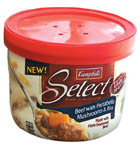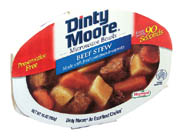
Shelf-stable meals, in such canned varieties as meats, vegetables and fruits, are by no means new, having been around since the 19th century. Since that time, such products have offered a more convenient alternative to from-scratch meals, and recent developments have led shelf-stable fare out of the can.
No matter the package, be it can, tray or box, the category faces a wide array of challengers for stomach share. In its new report on the shelf-stable meal market in the U.S., Mintel International Group's (Chicago) exclusive consumer research found consumption of heat-and-eat meals surpasses frozen, ready-to-eat foods and meal kits requiring meat (though finishing second to restaurant options). For its report, Mintel defines shelf-stable meals as packaged, prepared meals that require no refrigeration, no additional ingredients (except, in some cases, water) and minimal heating or cooking.
A look at the ages of shelf-stable meal consumers reveals this to be the range during which children most likely will be present in the household. As such, Mintel advises manufacturers to pursue any options that could make shelf-stable meal preparation more child-friendly. More than six in 10 parents regard the products as a “good way” to get food for kids' snacks and meals. To some degree, children participate in selecting the food, though parents remain the gatekeepers; any marketing effort should appeal to the children, while also addressing parents' concerns about food quality and the safety of children preparing it.
A wise strategy could be to capitalize on the parents' memories of their own childhood and fondness for the meals of that time. The category is another example of the trend toward comfort foods, with almost 40% regarding macaroni and cheese as one of their favorite comfort foods.

Big Mac & Cheese
With such high regards, it should be little surprise that macaroni and cheese is the category's top-selling segment, accounting for almost 38% of the market in 2003. Mintel's report covers a sales period from 1998 to 2003. During that time, the segment grew and declined in the same patterns as the category as a whole, yet sales of macaroni and cheese fell in the last two years, finally settling on a 9% growth in constant dollars during the six-year period. Kraft (Glenview, Ill.) dominates the segment, with a share of over 80%. Such a strong position has its drawbacks, however, considering Mintel suspects Kraft's product may be too familiar to build sales. Not that this has stopped the giant from trying. Kraft's primary efforts, though, have been to fight private-label products, which have begun eroding the giant's market share.
In 1998, the company launched Easy Mac, a large reason behind growth of the segment during the early years under review. The microwaveable product has continued to sell well, increasing sales by more than $10 million each year since 1999 and indicating the type of product likely to appeal to families short of time.
One and None
Kraft also leads the microwaveable entrée segment. Though not quite as dominant as in macaroni and cheese, Kraft's It's Pasta Anytime! holds a sizable share. In fact, Mintel describes the segment as It's Pasta Anytime! and everything else. The Kraft product was the segment's only entry that built sales between 2001 and 2003, benefiting at least in part from the marketing effort Kraft has put behind the product since acquiring it in 2001. However, the pasta item also serves as a prime example of catering to convenience, as it combines an easy preparation with a result comparable to its from-scratch competitors.Kraft's biggest competitor in the segment to date has been General Mills (Minneapolis), whose Betty Crocker Bowl Appétit launched in 2000. First-year sales for the product stood at a promising $27 million and continued the upward track in year two, but declines began in 2002.
Most products competing in this segment are found in small, microwaveable bowls, suitable for lunch bag use. However, Mintel believes certain of these may have a perception problem. Americans accustomed to large portions may regard these bowls as small and, furthermore, consumers increasingly are skipping lunch.
Time pressures have taken a toll even on convenient shelf-stable meals, as have declining cooking skills and increased levels of disposable income, the latter of which has been especially beneficial to sales in restaurants and fast food chains. On the positive side, shelf-stable meals do share some of the same benefits as foodservice: not having to cook (or knowing how to cook), and minimal clean-up. Furthermore, the price for shelf-stable meals can draw consumers looking for a less-expensive alternative to foodservice.
Restaurants are the most popular way to get a convenient meal, according to Mintel research, which found 7% of respondents claiming to have eaten restaurant fare six or more times in the previous week. Also, 23% of respondents have done so three to five times, leading to the conclusion that a level of convenience (beyond simply heating a can or opening a box and boiling water) is a vital key in choosing a meal.

Out of the Pasta
That being said, complete packaged dinner mixes and canned or jarred pasta remain popular, each used by more than six in 10 households. Shelf-stable pastas remain the category's second-largest segment, though constant dollar sales have dropped more than 8% since 1998. One of the segment's leaders, Campbell Soup's (Camden, N.J.) Franco American line has seen its sales steadily drop.However, the segment's sales did level out in 2003, and the segment may have hope in the form of some promising products that debuted in 2003. ConAgra's rollout of Chef Boyardee Stuffed and Homestyle in 1998 and 1999 led to the segment's only growth in 1999, but both were in decline by 2001. Chef Boyardee Mini Bits and new Twistaroni flavors such as Nacho Cheese and Chili Dog began to build sales in 2003, leading the segment to hold steady that year.
Direct competition may come from outside the segment, as Unilever's (Englewood Cliffs, N.J.) Ragu Pasta Express launched in 2001 and may well be a factor drawing sales from shelf-stable pastas. The microwaveable Ragu registered $20 million in sales in 2002.
Mintel fears the segment may be too rooted in the consumer mind as a children's meal. Campbell attempted to broaden the market with Franco American Superiore, canned pasta appealing to teen and adult tastes. However, the product did not achieve strong long-term sales.
Getting Chili
A few brands of prepared chili are building sales, though the majority experienced no change or declines each year. Marketing and expanding the reach of more-regional offerings can benefit the products; but overall, many consumers do not notice the products in the wake of newer, more heavily promoted food items. Constant-dollar sales of prepared chili stood at essentially the same level in 2003 as in 1998. “The forces at work on the chili segment,” Mintel asserts, “appear to be a conflict between consumers' desire for quick and easy to make foods and taste for spicier foods on the one hand, and their tendency toward disenchantment with older products on the other.”One company attempting to breathe new life into its longstanding line of products is Campbell. Under pressure from investors to reinvigorate its brands, the company already has revitalization efforts underway in soup, its Pepperidge Farm cookies and crackers and Pace salsa, and has plans to move on to its smaller brands, which likely would encompass Franco American pastas.
The category, as a whole, experienced sales declines during the last two years under review. Mintel attributes this to the majority of shelf-stable products not having changed significantly in decades. Any innovative introduction has the potential to be a growth driver for the category.
Mintel predicts sales of shelf-stable meals will decline 3% in constant prices through 2008, though the performance will not be the same throughout all of the various segments. Macaroni and cheese is expected to increase 11%, and prepared chili should jump 5%. Other segments, however, will not fare as well: a 26% drop is predicted for shelf-stable pastas; a 1% decline for microwaveable packaged dinners; and a 14% fall for prepared dinners/entrees.
For more information on the report mentioned in this article, “The U.S. Shelf-stable Meals Market,” contact Mintel International Group Ltd.; 213 W. Institute Place, Suite 208; Chicago, IL 60610; phone: 312-932-0400.
